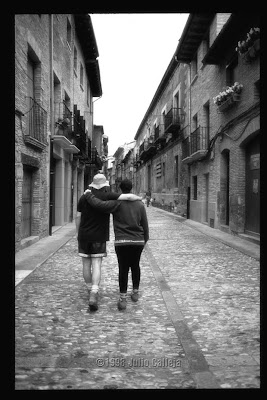
Debemos hacer una pequeña parada en el viaje para hacer un salto en el tiempo y en el espacio. Suponiendo que sean cosas diferentes.
Nos vamos, por hoy, a dar una vuelta por la casa.
Mañana volveremos al Camino.
Acabo de regresar de allí, tan solo cuatro dias cerca de los amigos y de la luz, cerca del oxigeno, el espacio infinito. La vida.
Y allí estaba ella, la Isla Pirata, detras de aquella curva, acostada, como siempre a los pies del Monte Facho, entre la bahía y el Cabo, esperando que los que la aman, vengan a despertarla para decirla ¿recordarla? lo bonita que es. Ella sigue, igual que siempre, jugando con el viento y con las mareas, indiferente a los temporales, y, como cada dia, desde el principio de los tiempos, ella sigue poniendose su perfume de aroma a pradera y a oceano, y se pone guapa con sus collares de conchas y algas marinas.
¿Quien puede no amarla?
We make a brief stop on the journey to make a leap in time and space. Assuming that things are different.
We're going, the moment, to walk around the house.
Tomorrow we will return to the Camino.
I just returned from there, just four days near the friends, and the light, the oxygen, the infinite space. The real life.
And there she was, Pirate Island, behind that curve, lying, as always at the foot of Mount Facho, between the bay and the Cape, hoping that those who love her, come to wake her to tell her ¿remember what beautiful you are?. She stands, as usual, playing with the wind and tide, oblivious to the storms, and as each day from the beginning of time, she is putting on her perfume scent of meadow and ocean, and it gets pretty necklaces with shells and seaweed.
Who can not love her?
Nos vamos, por hoy, a dar una vuelta por la casa.
Mañana volveremos al Camino.
Acabo de regresar de allí, tan solo cuatro dias cerca de los amigos y de la luz, cerca del oxigeno, el espacio infinito. La vida.
Y allí estaba ella, la Isla Pirata, detras de aquella curva, acostada, como siempre a los pies del Monte Facho, entre la bahía y el Cabo, esperando que los que la aman, vengan a despertarla para decirla ¿recordarla? lo bonita que es. Ella sigue, igual que siempre, jugando con el viento y con las mareas, indiferente a los temporales, y, como cada dia, desde el principio de los tiempos, ella sigue poniendose su perfume de aroma a pradera y a oceano, y se pone guapa con sus collares de conchas y algas marinas.
¿Quien puede no amarla?
We make a brief stop on the journey to make a leap in time and space. Assuming that things are different.
We're going, the moment, to walk around the house.
Tomorrow we will return to the Camino.
I just returned from there, just four days near the friends, and the light, the oxygen, the infinite space. The real life.
And there she was, Pirate Island, behind that curve, lying, as always at the foot of Mount Facho, between the bay and the Cape, hoping that those who love her, come to wake her to tell her ¿remember what beautiful you are?. She stands, as usual, playing with the wind and tide, oblivious to the storms, and as each day from the beginning of time, she is putting on her perfume scent of meadow and ocean, and it gets pretty necklaces with shells and seaweed.
Who can not love her?





